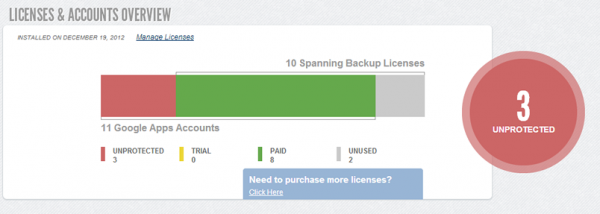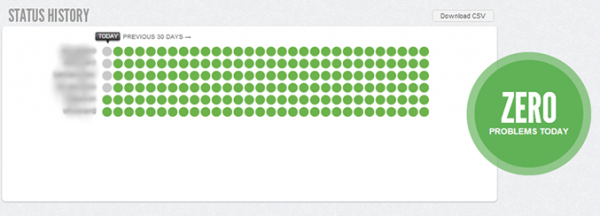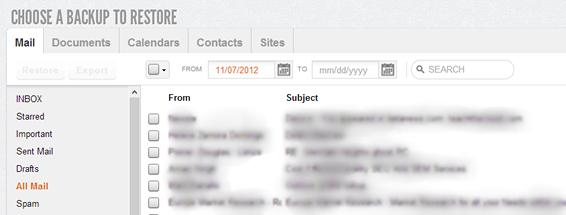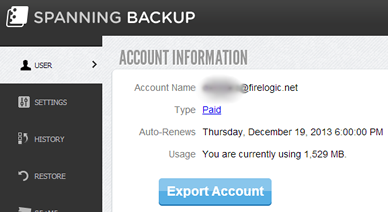
The competition in the Google Apps backup market is steadily ramping up, with more than a few contenders jumping in lately to have a piece of this newfound need. Just two months ago, I wrote about my (mostly) positive thoughts regarding Apps backup provider Backupify. But in order to do the competition justice, I decided to give the other popular alternative Spanning a run for the money.
Your choices don't stop at Spanning and Backupify, in case you're wondering. Google stepped into the backup arena with its first party Vault solution earlier last year, which takes the crown for being the most integrated option (for apparent reasons.) Some of the junior vendors in this space also include CloudAlly and SysCloudSoft. These two latter providers try to edge out Spanning and Backupify with better pricing, but they are not yet as established so it is tough to judge them on cost comparison alone.
For Google Apps administrators looking for a quality cloud backup solution, both Spanning and Backupify fit the bill at face value. Each provides varying degrees of data backup for the Apps platform, and both are quite cost-effective. But as I outlined in my writeup on Backupify back in December 2012, it does have a few shortcomings. Namely in offering no price discounts for the educational/nonprofit sectors and also in having some questionable inabilities like no true Google Sites restoration, as well as forced "all or nothing" restores as opposed to per-item selections.
Spanning is Well-organized and Visually Appealing
I know backup platforms aren't here to win fashion awards, but visual organization and a clean UI go a long way in creating a fully functional service. Case in point: Backupify doesn't have the worst UI in the cloud arena, but it surely wouldn't win any trophies from me. It took me a good 15-20 mins to get acquainted enough with Backupify to truly understand how to navigate the entire interface, and how it grouped backups, settings, etc.
Spanning spared me the lesson in software navigation. In short order, I quickly understood that moving around the backup service entailed two simple concepts. The first entails understanding what level of your domain you are browsing (the uppermost "domain" portion of your account, or a particular user account) and then the subsequent settings and available restoration options for that level. The contrasting color scheme goes a long way in creating simplistic experience that doesn't dumb down the interface, but saves me from having to go into the FAQ section to get my bearings straight.

Even non-technical admins can make their way around Spanning. The interface as a whole is a pleasure to navigate and you're never left wondering about where to go next.
Spanning takes a more Google Apps-esque viewpoint on assigning backup rights to accounts in your domain. Whereas Backupify opts to have mere on and off approach to which accounts are backed up, Spanning uses the licenses method that Google Apps admins should already be used to (since Google Apps forces you to purchase seats by licenses.) I wouldn't say I necessarily favor one approach over the other, but you can quickly reassign licenses and see how many are left at a glance.
Another area where I like Spanning in the visual department is its Status History page that shows you a simple dot matrix chart that corresponds to how backups went for each user over the past 30 days. Its clever, simple, yet intuitive and reduces the need for admins to waste time digging into status reports unnecessarily. In many ways, this page takes numerous cues from Google's own Status Dashboard, but I don't mind. The basis behind the idea works well.

Checking on your backup stats couldn't be simpler. Green is good, anything else deserves a second look. Clean, yet effective.
There are other small areas that aren't very crucial on the outset but become more useful in more nuanced scenarios. For example, there's no way in Backupify to view how much space each user is taking up in terms of backup needs. In Spanning, this is easily done on a single page that displays the largest users on top, using simple bars or varying sizes to denote storage space used. Other minor nuances persist throughout the service like bright, big buttons for changing options and visual cues that hit you over the head when something is wrong.
Backup and Restore Capabilities are Top-notch
I have to bite my tongue a bit, because I gave Backupify some high accolades for impressive capabilities. That was until I laid my hands on what Spanning offered Google Apps administrators. The level of features baked into the service are quite stellar, especially when you look at the bevy of options provided when it comes to restoration abilities.
For starters, Spanning introduces some welcome settings that allow you to adjust things like backup exclusions per account. By default the service has options configured that prevent shared documents and calendars from being backed up to a third party's (the sharing recipient) account. But as an admin, you may opt to change these settings for select users. In similar fashion, particularly email under certain labels can be excluded from backups if it serves little value to the user or organization.
The crown jewel of Spanning's prowess is clearly demonstrated on its Restore page that allows each user's data to be plucked back from oblivion. And here is where the differences between Spanning and Backupify are even greater, because Spanning allows for point-in-time restoration on top of multi-item restoration. Want to go back and merely bring back a copy of a Google Doc from two weeks ago, as well as a Google Presentation two days prior to that? With Spanning this is easy as ever, since the interface allows for complex searches that are visually succinct and easy to follow.

Spanning lets you see your inbox the way it stood at any point in time. Talk about detailed restoration.
Another important difference is that Spanning allows you to restore entire folder structure for your Google Drive account. In Backupify, to my best knowledge from past tests, folder structure was not kept intact and large, complex accounts became a miserable mess if a full restoration was needed due to data disaster. Spanning not only brings these files back but recreates where they sat, saving you endless hours in cleaning up your cloud storage drive.
The level of control provided on restores really does matter. Think about it: do most users truly make messes of their entire inbox or Google Drive account at a time? Not likely. Most of the time, in my own consulting experience, end users lose single files or emails and want the ability to bring those selective items back from the dead. Spanning simplifies this process to the lowest common denominator, and I can't commend it enough for this capability.
An item that may or may not matter to some organizations could also be the fact that Spanning can handle full restores on Google Sites within a domain. While Backupify does handle backup of Sites, it can only offer exports on them - not true restores. Many organizations I consult are choosing Google Sites as an alternative to Sharepoint these days, so this could be another tipping point in your own comparison search.

A colorful interface that has a dead simple menu structure. "It just works".
In keeping with their dedication to granular file control, Spanning goes a step further and allows for multi-selected file export. Want to download three files from someone's Google Drive that may be needed? You can do it with just a few clicks. The online interface for Spanning represents a simplistic version of Windows Explorer so even the most beginner of Google Apps admins will not feel overwhelmed with performing such tasks. Backupify has export capability on the various Apps, but they are primarily full service exports. The "all or nothing" mentality as I mentioned previously which is nice, but not great.
Spanning doesn't come without its flaws, however. While it allows you as admin to select whether end users can or can't change their backup settings, it doesn't let you, for example, pick and choose which options users can adjust. It would have been nice to see Spanning allow admins to let users adjust which mail labels they can/can't backup, but force full backups on each Drive account if necessary.
Also, while you can see how much storage space each user occupyies on the service at a glance, you can't tell what services account for the used space. Spanning could have taken a few functional cues from FlashPanel on that point, since the service excels in providing very good insight as to how much data is residing in both Drive and Email at any given time.
Minor grievances aside, Spanning provides an all around experience that is exemplary of what my wish list from a cloud backup provider looks like. Some companies excel in function, some in form - but Spanning seems to have hit it home in both areas, and to that, a much needed kudos.
Competitive Pricing and Proven Security Credentials
Lots of companies are very particular on the security credentials of auxiliary services my company recommends in the course of Google Apps and Office 365 consulting. And while I was pretty impressed with Backupify's claims about security, Spanning puts their money where their mouth is in the form of having achieved full SSAE 16 audit status.
This accreditation not only certified the level of security and standards in place for their technology backbone, but everything else encompassing employee protocol, customer communication, and much more. If everything else puts Spanning and other backup providers neck and neck, then this should be something to bring it over the top.
Before you wish to purchase, they provide the obligatory 14 day free trial. Getting signed up is a piece of cake. And on the pricing front, Spanning has another clear win. Their service costs a flat $40/year at face value ($35/year if you can find a discount code) and the most important factor here is that there is no storage cap. Backupify's lowest end tier places a 35GB cap on storage space per user, which could easily become a problem for execs who have 20GB in their email inboxes and another 20GB+ of Drive files to manage. Sure, you could go up to Backupify's $4/month plan but Spanning still has them beat in cost for the same feature set level.
I also knocked Backupify on their lack of discounts for the educational and nonprofit sectors. Spanning has, in contrast, been offering lofty 25-percent discounts for these two important markets, and this will definitely play a big part in many organizations' decisions. Google's own Vault may be the one platform that undercuts Spanning on cost, as they offer free Vault service to all students at any K-12 domain that purchases Vault for its entire staff base (at a cheap $10/user per year.) But for the feature set and multi-faceted capabilities of Spanning, Vault is tough to recommend above that of the former.
Whichever direction you decide to head with your organization, remember that the cloud still needs to be backed up like any other on-premise system. While it's very true that Google Apps and Office 365 both have the technical underpinnings to prevent systematic failure or data loss, they do nothing to prevent user-induced data loss. This is where you need to have some kind of solution in place, ready to help restore files in times of need.
The cloud is great as a whole, but data backup is something we just can't seem to shake. At least Spanning makes it foolproof easy.
Photo Credit: T. L. Furrer/Shutterstock
 Derrick Wlodarz is an IT professional who owns Park Ridge, IL (USA) based computer repair company FireLogic. He has over 7+ years of experience in the private and public technology sectors, holds numerous credentials from CompTIA and Microsoft, and is one of a handful of Google Apps Certified Trainers & Deployment Specialists in the States. He is an active member of CompTIA's Subject Matter Expert Technical Advisory Council that shapes the future of CompTIA examinations across the globe. You can reach out to him at info@firelogic.net.
Derrick Wlodarz is an IT professional who owns Park Ridge, IL (USA) based computer repair company FireLogic. He has over 7+ years of experience in the private and public technology sectors, holds numerous credentials from CompTIA and Microsoft, and is one of a handful of Google Apps Certified Trainers & Deployment Specialists in the States. He is an active member of CompTIA's Subject Matter Expert Technical Advisory Council that shapes the future of CompTIA examinations across the globe. You can reach out to him at info@firelogic.net.


 The timing could not be better. Yesterday my wife received her shiny new Nokia Lumia 822 and today she can now use it to play music from the streaming service Spotify. Oh, she probably will not because, not her thing, but she could, and that is the important thing because the option was not available to her, or any other Windows Phone 8 customers, yesterday.
The timing could not be better. Yesterday my wife received her shiny new Nokia Lumia 822 and today she can now use it to play music from the streaming service Spotify. Oh, she probably will not because, not her thing, but she could, and that is the important thing because the option was not available to her, or any other Windows Phone 8 customers, yesterday.
